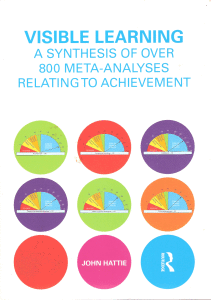 This is a graphical version of the list in John Hattie’s ‘Visible Learning‘.
This is a graphical version of the list in John Hattie’s ‘Visible Learning‘.
Hattie has headed a team of researchers for 20 years who have trawled the world for evidence about the effectiveness of teaching interventions. They have put all the results on the same scale (effect-size) and crunched the numbers from all the research. This table gives the results. (see limitations below)

Some of the labels used in the table are not self-explanatory, so do read the book before implementing the evidence! Remember also that this table includes several types of intervention: simple correlations, changes to the curriculum, teacher effects, etc
Limitations
Hattie’s work is not perfect. Several criticisms have been made, so this sections suggests how we can make best use of Hattie’s list
1 The numbers are inflated. The team used all the available evidence. Other research shows that small scale studies show a higher effect than more extensive research. This means that Hattie’s effect-size average is often higher than other calculations. However, the order of the list is unaffected and it gives us a good idea of the most effective things to try.
2 The top two on the list are correlations rather than effects. The first shows that, if you ask students to predict their grades, they are quite good at it. The second shows that, if you assess your students using a Piagetian test, rather than the topic they are studying, you get a similar rank-order of students. (In other words: clever students get better results). We can easily ignore these two as they are not classroom methods.
3 Are we comparing apples with oranges? We cannot be certain that the ‘cooperative learning’ in one experiment is the same as that in others. However, the effect-size shown is for an average of several experiments so, we can be confident that several variants of cooperative learning are effective. Also, since cooperative learning also appears on other lists we can be confident.
